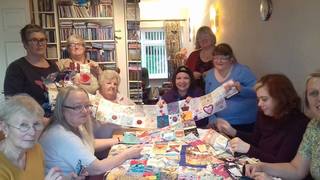
How do you turn hundreds of separate tales of murder, loss, grief and abuse into something positive? How do you turn a statistic that is at once both shocking and under-reported into something that tells stories and raises awareness?
For Gedling Labour Councillor Roxanne Ellis, this became more than an academic question when she was made aware of the Femicide Census. Based on the Counting Dead Women project by Karen Ingalla Smith, the Femicide Census lists the women who have died at the hands of men since 2009.
As Roxanne said: “Even though academically I knew that it was around two a week it wasn’t until I saw it all laid out that it truly struck home just how many it was. After that I thought that these women deserved to be more than numbers.”
Many of us when faced with such shocking numbers got angry. Roxanne on the other hand, got creative.
“The idea of the quilt came about because it is a traditionally feminine skill and one that is accessible to everyone, we have had women draw on their patch with pens, paint, stick, appliqué and embroider their patches. It is also one where people can work on their patches wherever they want and then they can be brought together. There was also inspiration taken from the AIDS quilt and the visual impact of that amazing piece of work.”
Women from all over the country have contributed their anger, their mourning, but more importantly their creativity and their celebration of the women who have been lost.
Andrea heard about the project from a friend on Facebook.
“I had a very cruel and abusive father. he did terrible things to my mother, most of which I was made to watch. My earliest memory is trying to pull him off her when he was on top of her, hitting her.”
Andrea’s mother eventually did leave her father, but was left with severe depression. She died some time later in a car accident and Andrea has never quite stopped blaming herself. When her father died four years ago, she felt nothing but relief.
“I wanted to be involved because it is a small way of alerting people to such an enormous problem in our society. My 12 year old daughter and I have done a patch each, which has given me the opportunity to talk to her about my experiences and to talk about how she must never be such a victim and what she can do. This has made me feel more open about the subject.”
Laura wanted to commemorate a teacher — Julie Ann Semper — who had meant a great deal to her who was later murdered.
“I met Julie while she was part of the student support at what used to be castle college. Our relationship was based around college, but we used to drink in the same pub after class ended! I first heard about the quilt when Roxanne told me about it and asked if I’d like to take part. I didn’t even make the connection in my brain about Julie to begin with until I looked at the names to choose from and it stood out to me — I knew that was the patch I wanted and needed to do as I knew her personally.”
Laura says “I hope [the quilt] will help recognise these women not as murder victims, but as the women they were beforehand.
This is echoed by Roxanne.
“What I hope to achieve is to start a conversation about domestic violence where victims become names and not numbers. In the long term I would like to see reporting changed to be more about the woman victims and not the male perpetrators. When researching the women included, often all the quilters could find about the woman was the way she had been killed.”
The quilt is nearly finished. It will be launched in Westminster Hall on International Women’s Day and is being supported by the Women’s Parliamentary Labour Party. When that’s done. The quilt is to go on tour. There are many who would like to see it displayed in their home towns or in honour of local victims who are commemorated in it. But this costs money. So there is now a Go Fund Me set up to see this happen. They are already over halfway to achieving their target.
Eventually, the quilt will be donated to a museum. But the community of women who have come together to create it remains strong. There have also been suggestions that they could start a new quilt for the women killed in 2016–17 for next International Women’s Day. Such an ambition is — of course — bitter sweet. One can only hope such a project would never be required. But with femicide at epidemic levels, sadly that seems a distant hope.
In the meantime, as is fitting, Roxanne should have the last — positive — word.
“We have really built an amazing community. One of our members said that she had never truly understood sisterhood until she took part in the quilt project.”.
Please consider donating to support the continued progress of the quilt and the work of celebrating the women murdered by men. To give a donation please go here.
No comments:
Post a Comment